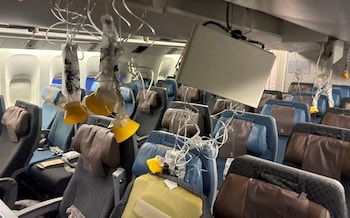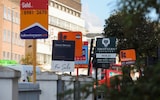At some point, every frequent flier will have seen the seatbelt signs ping on mid-trip, and experienced a sudden lurch as their aircraft is buffeted by gusts of air.
It is fortunately very rare for turbulence to end in disaster. But during a Singapore Airlines flight from London last month, passengers were thrown around the cabin and a man died from a heart attack.
The death was the first connected to the phenomenon in 23 years – and follows the safest year recorded for air travel in 2023, with no fatal accidents involving passenger jets anywhere in the world.
However, it came against a backdrop of steadliy increasing turbulence incidents. Just days later, a Dublin-bound service operated by Qatar Airways was buffeted over Turkey, leaving 12 people injured.
Airlines say it’s not clear whether the rise in turbulence stems from increasingly erratic weather patterns or is simply a result of the number of flights increasing by more than two-thirds in the past two decades.
Whatever the underlying cause, it was up there with the challenge of cutting carbon emissions as the hottest topic among airline bosses gathered in Dubai last week for the annual meeting of the International Air Transport Association (Iata).
While there was agreement on the need to gather more data, quite how far the industry might be prepared to go with efforts to mitigate the risk of injuries is less clear.
Sir Tim Clark, president of Emirates, the biggest long-haul airline, appeared to hint at an approach that could keep people in their seats for the whole flight.
He said: “Let’s be quite honest. If you haven’t got people strapped in, in some of the clear air turbulence interjections, it’s a real risk.
“So the whole industry is now upping the game with regard to making sure the passengers are strapped in. We are looking at all the protocols.
“I think that the industry will start being a lot more, let’s say, not restrictive, they will be more concerned about making sure that people are in their seats and strapped in.”
The comments sparked speculation that airline chiefs might be ready to adopt formal rules making it compulsory for people to remain belted up.
Iata pushed back against that suggestion, issuing a hasty press release that stated: “Airlines are not planning to require passengers to keep their seat belts on at all times.”
However, it reiterated that “airlines have long recommended that passengers fasten seatbelts when seated”.
Nick Careen, the organisation’s safety chief, told the summit: “When I get on an airplane I don’t take my seatbelt off unless I go to the washroom. I loosen it, but I keep it on. I think that’s pretty simple. It doesn’t take resources, it takes common sense.”
Careen said it’s now common in the US for pilots to tell passengers on “short flights” such as the near three-hour trip from Denver to Seattle (about the same as London to Malaga) that the seat belt sign will remain on throughout if there’s any potential for turbulence.
He said: “Seatbelts save lives in cars and air transport is no different. There used to be a time when passengers would get pretty impatient when that seat belt sign didn’t come off because they wanted their coffee, but now they realise it’s actually synonymous with safety.”
Whether a stag (or hen) party of Britons bound for Ibiza and eager for their next drink would be quite so understanding is open to debate.
Willie Walsh – Iata’s director general, one-time chief executive of British Airways and a former pilot – told the summit, while not playing down the issue, that “turbulence is nothing new”.
Mr Walsh said it was something he encountered frequently when he began flying with Aer Lingus 45 years ago. Crews then would make a report to air traffic controllers who would “pass the information on to other aircraft in the location if they had the opportunity”.
He said: “It’s been a factor in the industry for many, many years. We will continue to assess the recent events and try to understand if there’s anything else that can be done.”
The range of opinion captures the conundrum facing airlines as they grapple with the challenge of preventing turbulence-related deaths while at the same time avoiding a knee-jerk reaction that unnecessarily detracts from the passenger experience.
Turbulence comes in two forms. The best understood is encountered in clouds and at its most severe in thunderstorms, where aircraft can rise and fall sharply as they encounter rapidly moving air.
Modern weather forecasting and radars mean that the cumulonimbus formations that pose a risk are easily detectable.
Aircraft will divert or change their flight level to avoid threatening systems, while pilots have ample time to activate seatbelt signs and warn passengers.
More problematic is so-called clear air turbulence, or what used to be described as a “rough patch or air”. Striking in a cloudless sky, it sends drinks slopping, bellies lurching and has passengers staggering in the aisles – or worse.
This is often encountered along the flanks of mountain ranges, where air is forced rapidly higher, but can also be experienced in cloudless air affected by distant storm systems.
Changes in wind speeds associated with aircraft moving in and out of jet streams in the upper atmosphere are also a trigger.
It may be that the straying of jet streams further from the poles as the climate warms is even to blame for the increase in cases of turbulence.

A preliminary report into the Singapore Airlines incident found that the Boeing 777 encountered an updraft, after which it lurched up and down in less than five seconds, experiencing huge gravitational swings that caused those who weren’t strapped in to become airborne.
Briton Geoff Kitchen, 73, subsequently died from a heart attack and 58 people were admitted to hospital, 20 of them to intensive care.
The report didn’t specify the nature of the turbulence encountered, but, given that seatbelt signs weren’t initially illuminated, the pilots appear to have had very little warning.
Quite how much the threat from turbulence has increased is not entirely clear. Iata was not able to supply data on people hurt by turbulence, but says it is the biggest cause of in-cabin injuries, alongside burns from hot drinks and strains from lifting heavy bags.
The US Federal Aviation Administration lists 163 injuries as having been caused by turbulence in the 10 years to 2022, with the majority suffered by cabin crew and only 34 by passengers – fewer than the number hospitalised in the Singapore Airlines case.
At Emirates, however, Sir Tim says the trend has been clear for some time, and well in advance of the Singapore flight.
He said: “Well before that there was evidence that we were beginning to see a ticking up of the amount of turbulence. People say it’s climate change, some people say it’s because we’ve got many more flights than we used to have. But the fact is the incidence is going up.”
Sir Tim said that passengers will definitely see an increase in warnings flashing up on seat-back screens, and a propensity for pilots to be more proactive in feeding information to cabin crew and travellers.
Attendees flying to the Iata meeting with Emirates were regularly reminded about the virtues of buckling up, while seat-belt signs flashed on at the slightest sign of bumpy air.
At the same time, in-flight displays continued to extol the virtues of a mid-flight stroll (said to guard against the risk of deep vein thrombosis), and the sight of parents leading a bored toddler around the cavernous cabin of an A380 superjumbo remained as common as ever.
Iata is banking on its Turbulence Aware initiative, launched in 2018, to help alert carriers to the location of turbulent air pockets.
While only 21 of the group’s 330 members have so far signed up to the platform, which uses data from thousands of flights to provide real-time information on optimal flight paths, it says there has been a surge of interest following the Singapore incident.
Sir Tim Clark said real-time data is all well and good, but that airlines really need advance information on where turbulence might occur.
Artificial intelligence able to provide forecasts based on an analysis of weather patterns and the jet stream may hold the key.
He said: “We’re trying to use a bit of AI to give us a predictive analytic capability with regard to where turbulence is, but it’s very difficult.”
Whether turbulence is more common may be a matter of debate. But the warning to buckle up midway through a journey seems likely to become increasingly common.
Disclaimer: The copyright of this article belongs to the original author. Reposting this article is solely for the purpose of information dissemination and does not constitute any investment advice. If there is any infringement, please contact us immediately. We will make corrections or deletions as necessary. Thank you.



